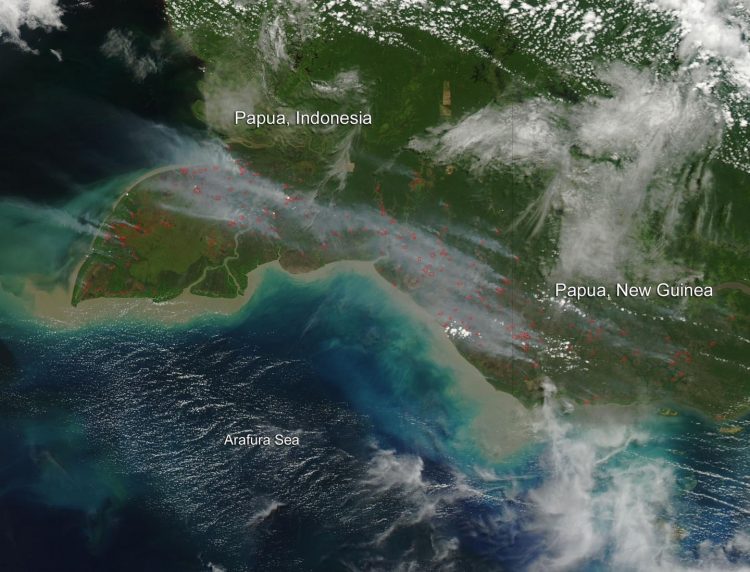Fires in Papua, Indonesia and New Guinea

This natural-color satellite image was collected by the Moderate Resolution Imaging Spectroradiometer (MODIS) aboard the Aqua satellite on Sept. 28, 2014. Actively burning areas, detected by MODIS's thermal bands, are outlined in red and there is smoke significant rising from these areas. Credit: NASA image courtesy Jeff Schmaltz, MODIS Rapid Response Team. Caption: NASA/Goddard, Lynn Jenner with information from NASA Study Says Climate Adds Fuel to Asian Wildfire Emissions
Palm oil is increasingly grown for use as a cooking oil and biofuel, while also replacing trans fats in processed foods.
It has become the most widely produced edible oil in the world, and production has swelled in recent years to surpass that of soybean oil.
The environmental effects of such growth have been significant. Land has to be cleared to grow the crop, and the preferred method is fire.
The clearing often occurs in drained peatlands that are otherwise swampy forests where the remains of past plant life have been submerged for centuries in as much as 60 feet of water.
Indonesia has become the third largest greenhouse gas emitter after the United States and China, due primarily to these fire emissions.
With an extended dry season, the peat surface dries out, catches fire, and the lack of rainfall can keep the fires going for months.”
This natural-color satellite image was collected by the Moderate Resolution Imaging Spectroradiometer (MODIS) aboard the Aqua satellite on September 28, 2014.
Actively burning areas, detected by MODIS's thermal bands, are outlined in red and there is smoke significant rising from these areas.
Media Contact
All latest news from the category: Earth Sciences
Earth Sciences (also referred to as Geosciences), which deals with basic issues surrounding our planet, plays a vital role in the area of energy and raw materials supply.
Earth Sciences comprises subjects such as geology, geography, geological informatics, paleontology, mineralogy, petrography, crystallography, geophysics, geodesy, glaciology, cartography, photogrammetry, meteorology and seismology, early-warning systems, earthquake research and polar research.
Newest articles

Superradiant atoms could push the boundaries of how precisely time can be measured
Superradiant atoms can help us measure time more precisely than ever. In a new study, researchers from the University of Copenhagen present a new method for measuring the time interval,…

Ion thermoelectric conversion devices for near room temperature
The electrode sheet of the thermoelectric device consists of ionic hydrogel, which is sandwiched between the electrodes to form, and the Prussian blue on the electrode undergoes a redox reaction…

Zap Energy achieves 37-million-degree temperatures in a compact device
New publication reports record electron temperatures for a small-scale, sheared-flow-stabilized Z-pinch fusion device. In the nine decades since humans first produced fusion reactions, only a few fusion technologies have demonstrated…





















